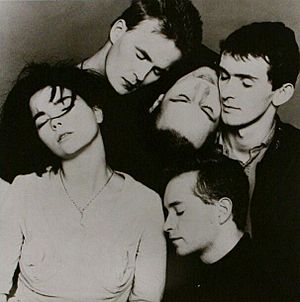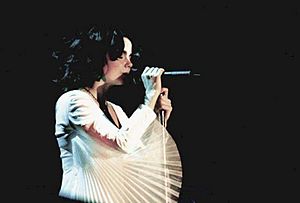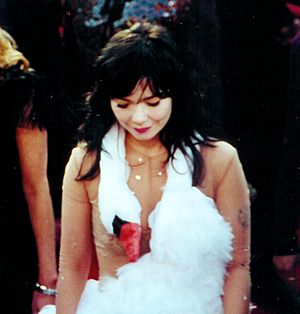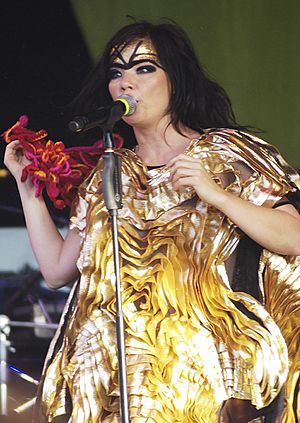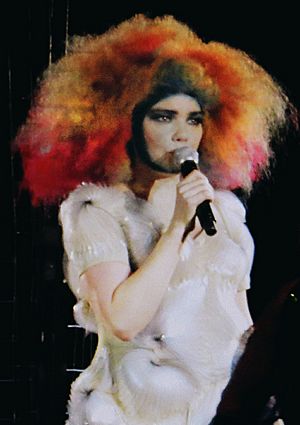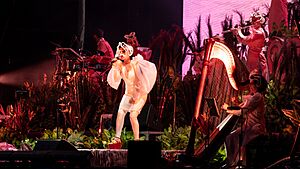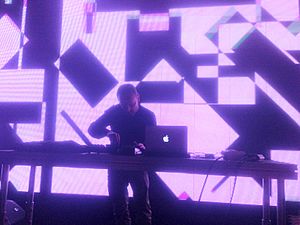Björk facts for kids
Quick facts for kids
Björk
OTF
|
|
|---|---|
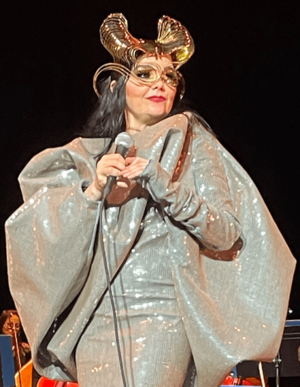
Björk performing in Paris during her Björk Orkestral show in 2022
|
|
| Born |
Björk Guðmundsdóttir
21 November 1965 Reykjavík, Iceland
|
| Occupation |
|
| Years active | 1968–present |
|
Notable work
|
|
| Spouse(s) |
Þór Eldon
(m. 1986; div. 1987) |
| Partner(s) | Matthew Barney (2002–2013) |
| Children | 2 |
| Parent(s) |
|
| Awards | Full list |
| Musical career | |
| Genres |
|
| Instruments |
|
| Labels | |
| Signature | |
 |
|
Björk Guðmundsdóttir (born 21 November 1965), known simply as Björk, is an Icelandic singer, songwriter, and actress. She is famous for her unique voice and creative musical style. Her music blends different genres like electronica, pop, dance, and jazz. Björk is seen as a leader in electronic and experimental music.
Born and raised in Reykjavík, Iceland, Björk started her music journey at age 11. She became well-known internationally as the lead singer of the alternative rock band the Sugarcubes. After the band broke up in 1992, Björk became a successful solo artist. Her albums like Debut (1993), Post (1995), and Homogenic (1997) mixed electronic and avant-garde sounds.
Björk has sold over 40 million records worldwide. Many of her albums have reached the top 20 on the US Billboard 200 chart. She has had many hit singles, including "It's Oh So Quiet" and "Army of Me". She has won five BRIT Awards and received 16 Grammy nominations. In 2015, Time magazine named her one of the 100 most influential people. Rolling Stone magazine has also recognized her as one of the greatest singers and songwriters of all time.
Björk also starred in the 2000 film Dancer in the Dark. For this role, she won the Best Actress Award at the 2000 Cannes Film Festival. She was also nominated for an Academy Award for Best Original Song for "I've Seen It All". Beyond music and film, Björk is an advocate for environmental causes in Iceland. A special exhibition about her work was held at New York's Museum of Modern Art in 2015.
Contents
- Life and Music Journey
- Early Life and First Steps in Music (1965–1984)
- The Sugarcubes Years (1985–1992)
- Solo Success: Debut and Post (1993–1996)
- Homogenic and Dancer in the Dark (1997–2000)
- Vespertine and Greatest Hits (2001–2003)
- Medúlla and Drawing Restraint 9 (2004–2006)
- Volta and Collaborations (2007–2010)
- Biophilia and Vulnicura (2011–2016)
- Utopia and Fossora (2017–Present)
- Music Style and Development
- Impact and Influence
- Personal Life
- Other Activities
- Music Albums
- Films and Videos
- Concert Tours
- Awards and Recognition
- Images for kids
- See also
Life and Music Journey
Early Life and First Steps in Music (1965–1984)
Björk Guðmundsdóttir was born on 21 November 1965 in Reykjavík. Her mother, Hildur Rúna Hauksdóttir, was an activist. Her father, Guðmundur Gunnarsson, was an electrician. Björk and her mother lived in a commune. Her stepfather was Sævar Árnason, a guitarist.
At age six, Björk started studying classical piano and flute at a music school in Reykjavík. After a school concert where she sang "I Love to Love", her teachers sent a recording to a radio station. A record label, Fálkinn, heard it and offered her a contract. Her first album, Björk, was released in Iceland in December 1977 when she was 11.
As a teenager, Björk formed a punk band called Spit and Snot. In 1980, she joined a jazz fusion group, Exodus. She also formed Tappi Tíkarrass in 1981, releasing an EP in 1982 and an album in 1983. This group was featured in the documentary Rokk í Reykjavík. Around this time, Björk also met poet Sjón, who became a lifelong friend and collaborator.
Later, Björk joined a group called Kukl (meaning "Sorcery" in Icelandic). They played gothic rock music. Kukl released their first single in 1983 and their first album, The Eye, in 1984. They toured Europe and were the first Icelandic band to play at Roskilde Festival in Denmark.
The Sugarcubes Years (1985–1992)
Kukl's second album came out in 1986, but the band later broke up. Björk then worked with Guðlaugur in a project called the Elgar Sisters. Some of their songs later appeared as B-sides on Björk's solo singles.
Björk had her first acting role in the film The Juniper Tree, filmed in 1986. She played Margit, a girl whose mother was accused of witchcraft. That summer, some friends formed an arts group called Smekkleysa (meaning "Bad Taste"). They started a band to make money, which became known as Sykurmolarnir ("Sugarcubes" in Icelandic). Their first single, "Ammæli" ("Birthday"), was released on Björk's 21st birthday, 21 November 1986.
The Sugarcubes signed with One Little Indian and released their first English single, "Birthday", in 1987. It was a big hit in the UK. They also signed with Elektra Records in the US. Their first album, Life's Too Good, came out in 1988 and sold over one million copies. The band toured North America and appeared on Saturday Night Live.
During a break from the Sugarcubes, Björk started working on her own music. In 1990, she recorded Gling-Gló, a collection of jazz songs, with the group Tríó Guðmundar Ingólfssonar. This album became her best-selling record in Iceland. She also sang on songs for 808 State's album ex:el, which sparked her interest in house music.
Björk decided to leave the Sugarcubes to focus on her solo career. They released one last album, Stick Around for Joy (1992), and went on a final tour. The Sugarcubes then split up after a last show in Reykjavík. Rolling Stone magazine called them "the biggest rock band to emerge from Iceland."
Solo Success: Debut and Post (1993–1996)
Björk moved to London to start her solo career. She worked with producer Nellee Hooper. Their collaboration led to her first international solo hit, "Human Behaviour". This dance track featured a guitar rhythm from Antônio Carlos Jobim. The music video for the song, directed by Michel Gondry, was very popular on MTV.
Her first solo album, Debut, was released in June 1993. It received great reviews and became a platinum album in the United States. Björk named it Debut to show it was a new beginning for her. The album included songs she had written since she was a teenager, mixed with new collaborations. Debut combined different styles like dance, Bollywood-inspired strings, and jazz.
At the 1994 Brit Awards, Björk won awards for Best International Female Artist and Best International Newcomer. Her success allowed her to work with other artists. She collaborated on "Play Dead" for a film and co-wrote "Bedtime Story" for Madonna.
Post, her second solo album, was released in June 1995. She worked with producers like Nellee Hooper, Tricky, and Howie B. Building on Debut's success, Björk explored more dance and techno sounds. The album was praised for its variety and emotional depth. It included songs with industrial beats like "Army of Me". Post was certified platinum in the US and included several UK pop hits.
Homogenic and Dancer in the Dark (1997–2000)
Björk moved to Spain to record her album Homogenic, released in 1997. She worked with producers Mark Bell and Howie B. Homogenic is known as one of Björk's most experimental albums. It features strong beats that reflect the landscape of Iceland, especially in the song "Jóga". The album was certified gold in the US in 2001.
The album had several music videos that were played on MTV. The video for "Bachelorette" was directed by Michel Gondry. The video for "All Is Full of Love" was directed by Chris Cunningham. "All is Full of Love" was also the first DVD single released in the US. Björk started writing more personal songs during this time.
In 1999, Björk was asked to create music for the film Dancer in the Dark. The director, Lars von Trier, then asked her to act in the film as the main character, Selma. She accepted, and the film premiered in 2000. It won the Palme d'Or award, and Björk won the Best Actress Award. The music she created for the film was released as the album Selmasongs. This album included a duet with Thom Yorke called "I've Seen It All", which was nominated for an Academy Award for Best Original Song. Björk performed the song at the 2001 Oscars, wearing her famous swan dress.
Vespertine and Greatest Hits (2001–2003)
In 2001, Björk released the album Vespertine. This album featured soft vocals, tiny beats made from everyday sounds, and personal themes. She worked with experimental musicians like Matmos and Zeena Parkins. The album's lyrics were inspired by poets like E. E. Cummings. To go with the album, a book of her writings and photos was published. Björk went on the Vespertine world tour, performing in theaters and opera houses for the best sound. Vespertine was her fastest-selling album at the time, selling two million copies by the end of 2001.
Vespertine had three singles: "Hidden Place", "Pagan Poetry", and "Cocoon". The video for "Pagan Poetry" caused some discussion due to its imagery. In 2002, Björk was asked to record "Gollum's Song" for The Lord of the Rings: The Two Towers but declined because she was pregnant.
In 2002, the CD box set Family Tree was released. It included rare songs and unreleased versions of her music. Also released was Greatest Hits, with songs chosen by her fans. A DVD version included all her solo music videos. The new single from the set, "It's in Our Hands", featured a heavily pregnant Björk in its video. She gave birth to her daughter, Isadora, on 3 October 2002.
Medúlla and Drawing Restraint 9 (2004–2006)
In August 2004, Björk released Medúlla. She initially planned for it to be an album made entirely of human voices. While most sounds are vocal, it also includes some electronic programming and instruments. Björk featured throat singer Tanya Tagaq, hip hop beatboxer Rahzel, and other vocalists. Medúlla became her highest-charting album in the US at the time, reaching number 14.
In August 2004, Björk performed "Oceania" at the Opening Ceremony of the 2004 Summer Olympics in Athens. As she sang, her dress unfolded into a huge map of the world. The song was written for the event and featured a Leeds-based beatboxer, Shlomo.
In 2005, Björk worked with her partner Matthew Barney on the experimental art film Drawing Restraint 9. Both appeared in the film, which explored Japanese culture. Björk also created the film's soundtrack. She was nominated for Best International Female Solo Artist at the BRIT Awards again. In October 2005, she received the Inspiration Award at the Q Magazine Awards. In 2006, Björk re-released her first three solo albums and two soundtrack albums in a box set called Surrounded. Her former band, the Sugarcubes, reunited for a concert in Reykjavík in November 2006.
Volta and Collaborations (2007–2010)
Björk's sixth studio album, Volta, was released on 1 May 2007. It included collaborations with hip hop producer Timbaland, singer Anohni, and poet Sjón. The album also featured a brass ensemble and instruments like the kora and pipa. Volta became her first top 10 album in the US, debuting at number nine on the Billboard 200 chart.
The first single from Volta, "Earth Intruders", was released digitally in April 2007. The second single, "Innocence", had a music video chosen from a contest. Björk then went on the 18-month The Volta tour, performing at many festivals around the world.
In 2010, Björk received the Polar Music Prize alongside Ennio Morricone. She also collaborated with Dirty Projectors on an EP called Mount Wittenberg Orca, released to raise money for marine conservation. Björk released "The Comet Song" for the movie Moomins and the Comet Chase. She also sang duets with Ólöf Arnalds and Anohni. In December 2010, a previously unreleased song, "Trance", was used as the backing track for a short film honoring designer Alexander McQueen.
Biophilia and Vulnicura (2011–2016)
Biophilia was released in 2011. This album project combined music with technology and themes of science and nature. It included an "app album" and educational programs for children. The Biophilia tour lasted for two years.
The first single from Biophilia, "Crystalline", was released in June 2011. It was made using a special instrument called the "gameleste". A key part of Biophilia was a series of interactive iPad apps, one for each song. Biophilia was the first album ever released as a series of interactive apps. The project also included workshops for schoolchildren, exploring music and science.
In 2012, she released the remix album Bastards. In 2013, Björk appeared in a Channel 4 documentary with Sir David Attenborough called When Björk Met Attenborough. They discussed the connection between humans and music. In 2014, the Biophilia apps were added to the Museum of Modern Art's permanent collection. A concert film, Björk: Biophilia Live, was released worldwide.
Björk worked with producers Arca and the Haxan Cloak on her eighth studio album, Vulnicura. It was released in January 2015, earlier than planned, after it was leaked online. Vulnicura is about her breakup with former partner, Matthew Barney. Its lyrics are very emotional. Björk started her world tour in March 2015, performing songs from Vulnicura and her older albums.
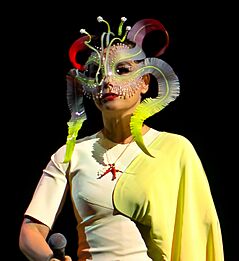
New York's MoMA held a retrospective exhibition from March to June 2015. It showed Björk's career from Debut to Biophilia, including parts of Vulnicura. The exhibition featured her unique instruments, music videos, notebooks, and costumes. A book called Björk: Archives was also published. Videos for "Lionsong", "Stonemilker" (a 360-degree VR video), "Family", and "Mouth Mantra" were made for the album.
In October 2015, Vulnicura Strings was announced. This album is an acoustic version of Vulnicura, featuring string arrangements and a special instrument called the viola organista. Vulnicura Live was also released, featuring live performances. In December 2015, Vulnicura was nominated for a Grammy Award for Best Alternative Music Album.
Björk launched Björk Digital in June 2016, a virtual reality exhibit. It showed all the VR videos made for Vulnicura, including the premiere of "Notget". She also DJ'd at the opening parties. During the exhibit in Tokyo, Björk made history with the world's first virtual reality live stream broadcast on YouTube.
Utopia and Fossora (2017–Present)
On 2 August 2017, Björk announced a new album. The first single, "The Gate", was released on 15 September 2017, with a video directed by Andrew Thomas Huang. On the same day, Björk announced the album title: Utopia.
Utopia was released on 24 November 2017. Björk described it as being about "that search (for utopia) – and about being in love." She produced the album with Arca, who she also worked with on Vulnicura. Björk called their collaboration "the strongest musical relationship" she's had. Utopia was nominated for Best Alternative Music Album at the 61st Annual Grammy Awards.
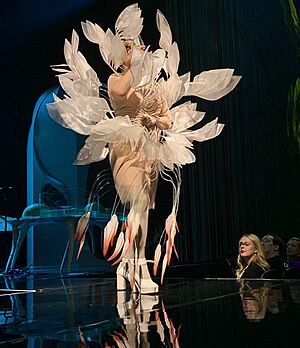
In May 2018, Björk performed on Later... with Jools Holland. She then went on a short Utopia tour, playing at European music festivals. In November 2018, Björk announced a new concert show called Cornucopia. It opened in May 2019 in New York and was described as her "most elaborate staged concert to date." The show then traveled to Mexico and Europe. Björk released music videos for "Tabula Rasa" and "Losss", which were used as backdrops during the shows.
In September 2019, Björk made a surprise appearance during Arca's performance art piece, debuting a new song called "Afterwards". This song was included on Arca's album KiCk i in June 2020. Björk then started her eleventh concert tour, Björk Orkestral, performing orchestral versions of her songs. This tour took place from 2021 to 2023.
In August 2020, Björk joined the cast of The Northman, a film by Robert Eggers. Her daughter, Ísadóra Bjarkardóttir Barney, also made her acting debut in the film. It was released in April 2022.
In August 2022, Björk announced her tenth studio album, Fossora, a Latin word meaning "digging". Fossora was released on 30 September 2022. It was supported by four singles: "Atopos", "Ovule", "Ancestress", and the title track. In September 2022, Björk also started a podcast called Björk: Sonic Symbolism. In it, she talks about the sounds and feelings of each of her albums.
Björk released the single "Oral" in November 2023, featuring Rosalía. This song was written earlier in her career and reworked to support people in Seyðisfjörður, Iceland. The song aims to help their campaign against fish farming that could harm local nature. The money from this song goes to Aegis, an environmental group Björk co-founded.
In 2024, Björk appeared on the cover of Vogue Scandinavia. In October, a new butterfly species was named Pterourus bjorkae in her honor. In 2025, Cornucopia, a concert film from her tour, premiered on Apple TV+.
Music Style and Development
What is Björk's Music Style?
Over her four-decade career, Björk has created a unique and avant-garde musical style. It includes elements of electronic, dance, trip hop, experimental, jazz, and contemporary classical music. Her music is hard to put into one category. Even though she often calls herself a pop artist, she is known for being a "restlessly experimental creative force."
Her album Debut helped bring electronic music into mainstream pop. Björk's work often explores the connection between nature and technology. Many describe her music as "artpop" because it combines art and popular music in a special way.
Björk often works with many different artists, photographers, fashion designers, and music video directors. She believes that her male collaborators sometimes get more credit than she does, which she thinks is because she is a female artist.
How Has Her Music Changed Over Time?
Early in her career, Björk played in bands with different music styles. She was in a punk rock band, a jazz fusion group, and post-punk and gothic rock bands. When she was with Tappi Tíkarrass, she was influenced by British new wave bands like Siouxsie and the Banshees. Her jazz album Gling-Gló (1990) showed her ability to sing in a classic jazz style. The Sugarcubes played avant-pop and alternative rock.
When Björk moved to London, she became interested in underground club culture. This helped her find her own musical identity. Debut (1993) mixed electronic, house, jazz, and trip hop. Björk said that dance music was the only "pop music that is truly modern" at the time. The album reflected the music scene in London in the early 1990s, including the growing trip-hop scene.
The 1995 album Post is known for its wide range of styles. It's considered a key Björk album because of its changing forms and emotional depth. The album was written after she moved to England and reflected her new fast-paced city life. Post built on the dance-pop style of Debut but added more influences from around the world. It included styles like industrial music, big-band jazz, and experimental music. Björk often balances electronic and "real" instruments in her music.
For her 1997 album Homogenic, Björk wanted to create a simpler, more focused record. This album was inspired by her home country, Iceland. It combined cool strings, unique electronic beats, and sounds like accordion and glass harmonica. Björk used a traditional Icelandic singing method that mixes speaking and singing. Homogenic showed her continued interest in electronic dance music and techno.
On the 2001 album Vespertine, Björk continued to blend organic and electronic sounds. However, Vespertine was more focused on personal and intimate themes. It had sharper melodies, minimalistic production, and lyrics inspired by poetry. The album also used many loops, static, and white noise. Björk's vocals on this album were often a soft, "unstable whisper," making the songs feel very close and personal.
Björk's 2004 album, Medúlla, is made almost entirely with human voices. It draws influences from folk to medieval music. The album combines beatboxing, classical choirs, and unique vocal sounds from artists like Mike Patton and Tanya Tagaq. It includes vocal pieces that sound like chamber music and tracks connected to hip-hop.
Volta, released in 2007, included R&B producer Timbaland. However, it was not a typical pop album. It balanced her lively 90s pop works with her experimental music from the 2000s. Björk wanted the album's beats to be "effortless" and "primitive." It features a large brass ensemble, drums, and "ethnic instruments" like likembé and kora.
Biophilia, from 2011, showed Björk's more experimental side. It has been compared to composers like Stockhausen. The song "Moon" combines natural ideas with human impact.
Her 2015 album, Vulnicura, focuses on Björk's voice, orchestral strings, and electronic beats. This combination was also in Homogenic, as both albums deal with themes of "heartbreak and perseverance."
In 2017, Björk released Utopia. This album brought back elements from Vespertine and Homogenic, mixing organic and electronic sounds. It is known as Björk's flute album, similar to how Vespertine used the celeste. Arca and Björk worked very closely on this album's production.
In September 2022, Björk launched the podcast Björk: Sonic Symbolism. In it, she talks about the sounds, moods, and rhythms of each of her ten albums with friends and collaborators.
Björk's Voice
Björk is a soprano singer with a wide range. Her singing voice has been described as "elastic" and "somersaulting." She is also praised for her unique vocal style and scatting ability. Critics say her voice has become even more powerful with age.
In late 2012, Björk had surgery for a polyp on her vocal cords. After the procedure, she felt her voice was as good as before. National Public Radio included Björk in its list of "50 Great Voices." MTV ranked her among the "22 Greatest Voices in Music." Rolling Stone praised her voice as unique, fresh, and versatile, fitting many different music styles.
Impact and Influence
Musicians from many different genres look up to Björk and say she has inspired them. These artists include Solange Knowles, Danny Brown, Beyoncé, Perfume Genius, Travis Scott, SZA, Ellie Goulding, Missy Elliot, Mike Shinoda of Linkin Park, Mitski, Christine and the Queens, AURORA, Kali Uchis, Kelela, Prince, Maggie Rogers, Amy Lee, Poppy, Corinne Bailey Rae, Jeff Buckley, Hayley Williams of Paramore, Geddy Lee of Rush, Willow Smith, Caroline Polachek, and Loreen.
In 2023, Rolling Stone magazine ranked her as 64th on their list of the 200 Greatest Singers of All Time.
Personal Life
When forming the Sugarcubes, Björk was briefly married to guitarist Þór Eldon. They had a son, Sindri Eldon Þórsson, born on 8 June 1986. They divorced later that year but continued to work together in the band. Sindri now has a child, making Björk a grandmother.
Life in London and Spain
After the Sugarcubes broke up, Björk moved to London. She was offered a record deal right away. She was engaged to London-based DJ Goldie for a time. Björk also had a brief relationship with musician Tricky in the 1990s. During this period, she became involved with the trip hop music scene. She also started working with fashion designer Alexander McQueen.
In London, Björk found public life and constant attention from the paparazzi difficult. She moved to Spain after a serious incident involving a stalker, Ricardo López. In September 1996, an obsessed fan sent a dangerous package to her London home. The package was found and safely handled by the police before it reached her. Björk was very upset by the incident and said it scared her. She moved to Spain to record her album Homogenic away from the media. She also hired security for her son, Sindri.
In February 1996, Björk had an incident with a photographer at Bangkok International Airport. She had asked the press to leave her and her son alone. When a reporter approached her son, Björk reacted strongly. She later apologized to the reporter. In January 2008, she had another incident with a photographer at Auckland International Airport.
Relationship with Matthew Barney
In the late 1990s, Björk lived in New York and met artist Matthew Barney. They started a relationship and moved in together in 2000. Their daughter, Ísadóra Bjarkardóttir Barney, was born in 2002. Björk and Barney worked together on Barney's art film Drawing Restraint 9, released in 2005. The couple broke up in 2013. Björk described the breakup as "the most painful thing" she had experienced. Her album Vulnicura, especially the song "Black Lake", was written about this breakup. Björk now spends half of each year in the US and the other half in Iceland with her daughter.
Other Activities
Helping Others
After the tsunami in Southeast Asia in late 2004, Björk started a project called Army of Me: Remixes and Covers. This project aimed to raise money for a relief fund. Fans and musicians from around the world covered or remixed her 1995 song "Army of Me." Björk chose the best 20 versions for the album. By January 2006, the album had raised about £250,000 for UNICEF's work in the region. Björk visited Banda Aceh in February 2006 to see UNICEF's work with children affected by the tsunami.
On 2 July 2005, Björk performed at the Live 8 concert in Japan. She headlined the show with other artists.
Environmental Work
Björk is very interested in environmental issues in Iceland. In 2004, she took part in the Hætta concert in Reykjavík. This concert protested against the building of Alcoa aluminium smelters, which would make Iceland the biggest smelter in Europe. She founded an organization called Náttúra. Its goal is to protect Icelandic nature and support local industries.
In October 2008, Björk wrote an article for The Times about the Icelandic economy. She shared her ideas on how to use natural resources to help the country. She also helped set up a fund called BJÖRK with Audur Capital. This fund supports sustainable industries in Iceland.
In 2014, Björk helped organize "Stopp, Let's Protect the Park." This event raised money and awareness for protecting Icelandic nature. It included a show at Harpa Concert Hall where she performed. The concert raised a lot of money to help establish a national park.
In 2022, Björk said she moved back to Iceland partly because of gun violence in the United States.
Supporting New Artists
Throughout her career, Björk has often used her influence to help new artists.
One example is electronica producer Leila Arab. Björk first invited Arab to play keyboards and sing backup on her first solo tour in 1993. Later, Arab experimented with live mixing during Björk's 1995 tour. This experience helped Arab start her own solo music career.
In 1998, Björk started her own small record label, Ear Records. She signed her longtime friend Magga Stína, who released her debut album. Björk also invited Magga to perform as her opening act on the Homogenic tour.
In 2001, Björk discovered Canadian Inuk throat singer Tanya Tagaq. She invited Tagaq to perform on her Vespertine world tour. In 2004, Tagaq collaborated on Björk's album Medúlla.
In 2004, Björk learned about Finnish artist Heidi Kilpeläinen, known as HK119. Björk started mentioning HK119 in interviews, and HK119 was later signed to Björk's record label, One Little Indian Records. Björk praised HK119's unique and simple work.
In 2009, Björk used her website and radio interviews to promote other new artists. She supported Icelandic musician Ólöf Arnalds and encouraged her label to re-release Arnalds's album. She also praised English artist Micachu and Syrian vocalist Omar Souleyman.
Music Albums
- Debut (1993)
- Post (1995)
- Homogenic (1997)
- Vespertine (2001)
- Medúlla (2004)
- Volta (2007)
- Biophilia (2011)
- Vulnicura (2015)
- Utopia (2017)
- Fossora (2022)
Films and Videos
- The Juniper Tree (1990)
- Dancer in the Dark (2000)
- Drawing Restraint 9 (2005)
- The Northman (2022)
Concert Tours
- Debut tour (1993–1994)
- Post tour (1995–1997)
- Homogenic tour (1997–1999)
- Vespertine world tour (2001)
- Greatest Hits tour (2003)
- The Volta tour (2007–2008)
- Biophilia tour (2011–2013)
- Vulnicura tour (2015–2017)
- Utopia tour (2018)
- Cornucopia (2019–2023)
- Björk Orkestral (2021–2023)
Awards and Recognition
Björk has received many awards for her music. On 26 April 1997, she received the Order of the Falcon, an important honor in Iceland.
Images for kids
See also
 In Spanish: Björk para niños
In Spanish: Björk para niños


